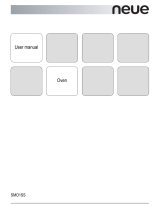
• Before maintenance, deactivate the
appliance and disconnect the mains
plug from the mains socket.
• Make sure the appliance is cold. There
is the risk that the glass panels can
break.
• Replace immediately the door glass
panels when they are damaged. Con-
tact the Service.
• Be careful when you remove the door
from the appliance. The door is heavy!
• Clean regularly the appliance to pre-
vent the deterioration of the surface
material.
• Remaining fat or food in the appliance
can cause fire.
• Clean the appliance with a moist soft
cloth. Only use neutral detergents. Do
not use abrasive products, abrasive
cleaning pads, solvents or metal ob-
jects.
• If you use an oven spray, obey the
safety instructions on the packaging.
• Do not clean the catalytic enamel (if
applicable) with any kind of detergent.
Pyrolytic cleaning
WARNING!
Risk of Injury / Fires / Chemical
Emissions (Fumes) in Pyrolitic
Mode.
• Before carrying out a Pyrolitic self-
cleaning function or the First Use of
the appliance remove from the oven
cavity:
– Any excess food residues, oil or
grease spills / deposits.
– Any removable objects (including
shelves, side rails etc., provided with
the product) particularly any non-
stick pots, pans, trays, utensils etc.
• Read carefully all the instructions for
Pyrolytic cleaning.
• Keep children away from the appli-
ance while the Pyrolytic cleaning is in
operation. The appliance becomes
very hot and hot air is released from
the front cooling vents.
• Pyrolitic cleaning is a high tempera-
ture operation that can release fumes
from cooking residues and construc-
tion materials, as such consumers
must:
– Provide good ventilation during and
after the first use at maximum tem-
perature operation.
– Provide good ventilation during and
after each Pyrolytic cleaning.
• Unlike all humans, some birds and
reptiles can be extremely sensitive to
potential fumes emitted during the
cleaning process of all Pyrolytic
Ovens.
– Remove any pets (especially birds)
from the vicinity of the appliance lo-
cation during and after the Pyrolytic
cleaning and first use maximum
temperature operation to a well-
ventilated area.
• Small pets can also be highly sensitive
to the localized temperature changes
in the vicinity of all Pyrolytic Ovens.
• Non-stick surfaces on pots, pans,
trays, utensils etc., can be damaged
by the high temperature Pyrolytic
cleaning operation of all Pyrolytic
Ovens and can be also a source for
low level harmful chemical fumes.
• Fumes released from all Pyrolytic
Ovens / Cooking Residues as descri-
bed are not harmful to humans, in-
cluding infants or persons with medi-
cal conditions.
2.4 Internal light
• The type of light bulb or halogen lamp
used for this appliance, is only for
household appliances. Do not use it
for house lighting.
WARNING!
Risk of electrical shock.
• Before replacing the lamp, disconnect
the appliance from the power supply.
• Only use lamps with the same specifi-
cations.
2.5 Disposal
WARNING!
Risk of injury or suffocation.
• Disconnect the appliance from the
mains supply.
• Cut off the mains cable and discard it.
6
www.aeg.com





















